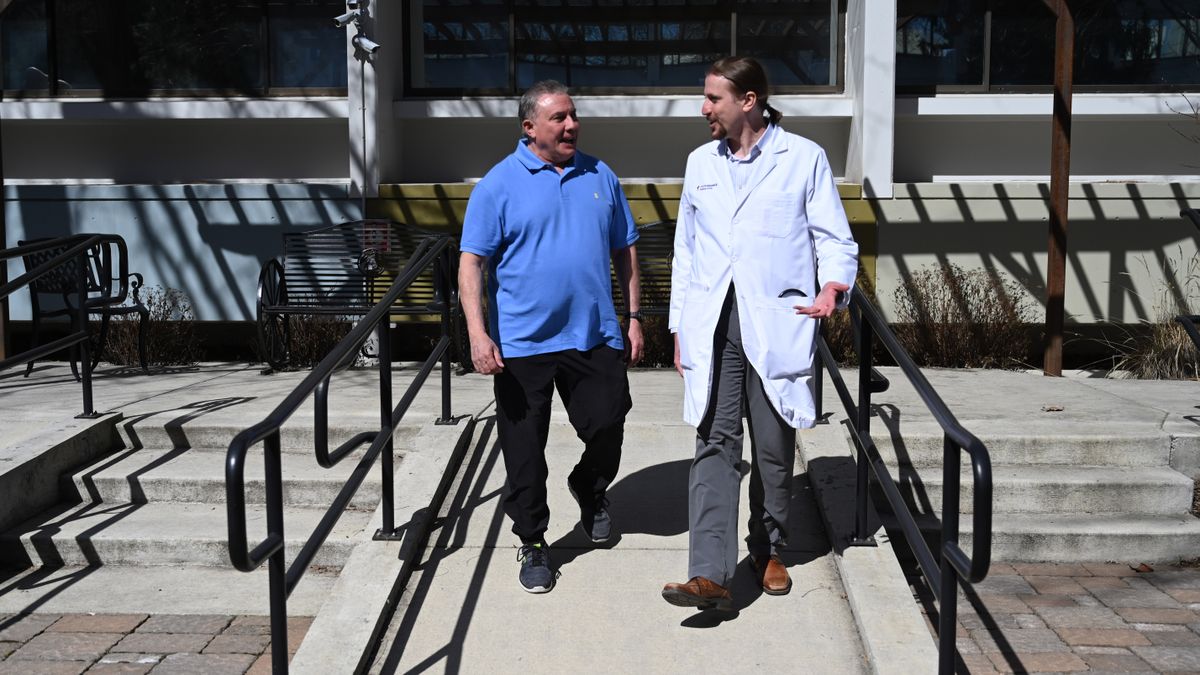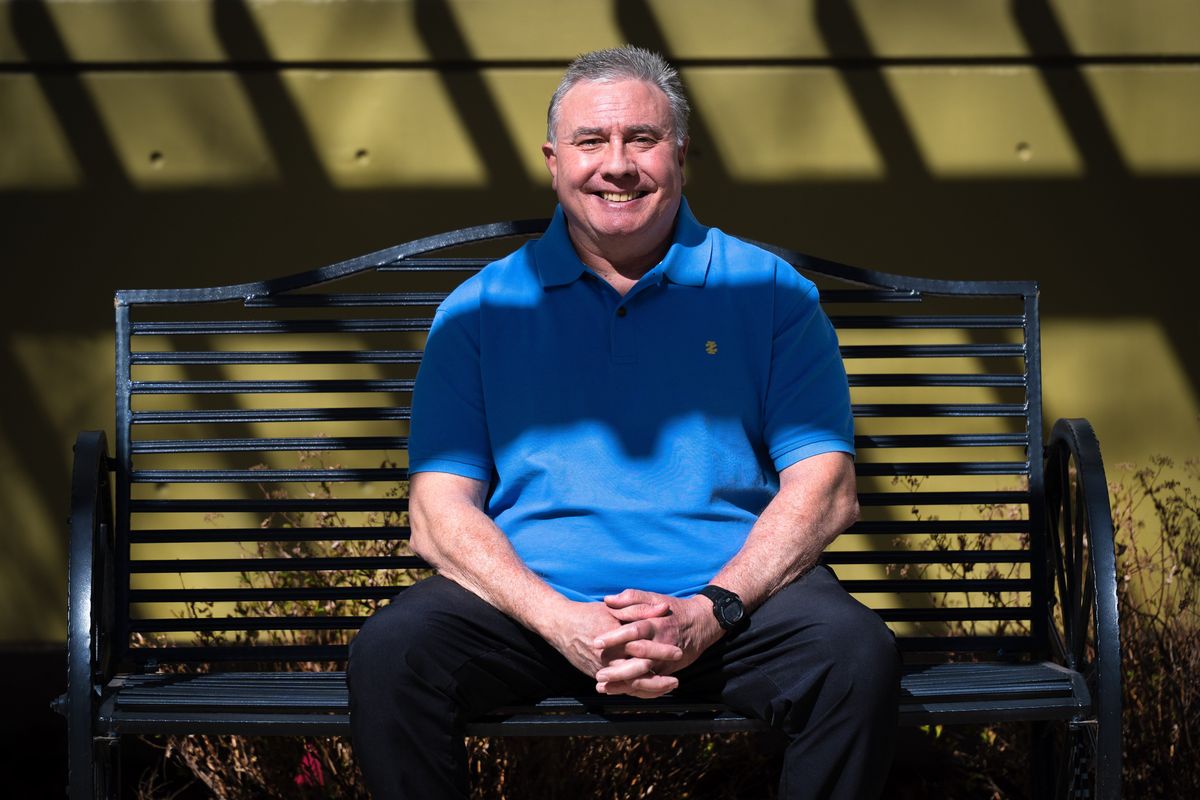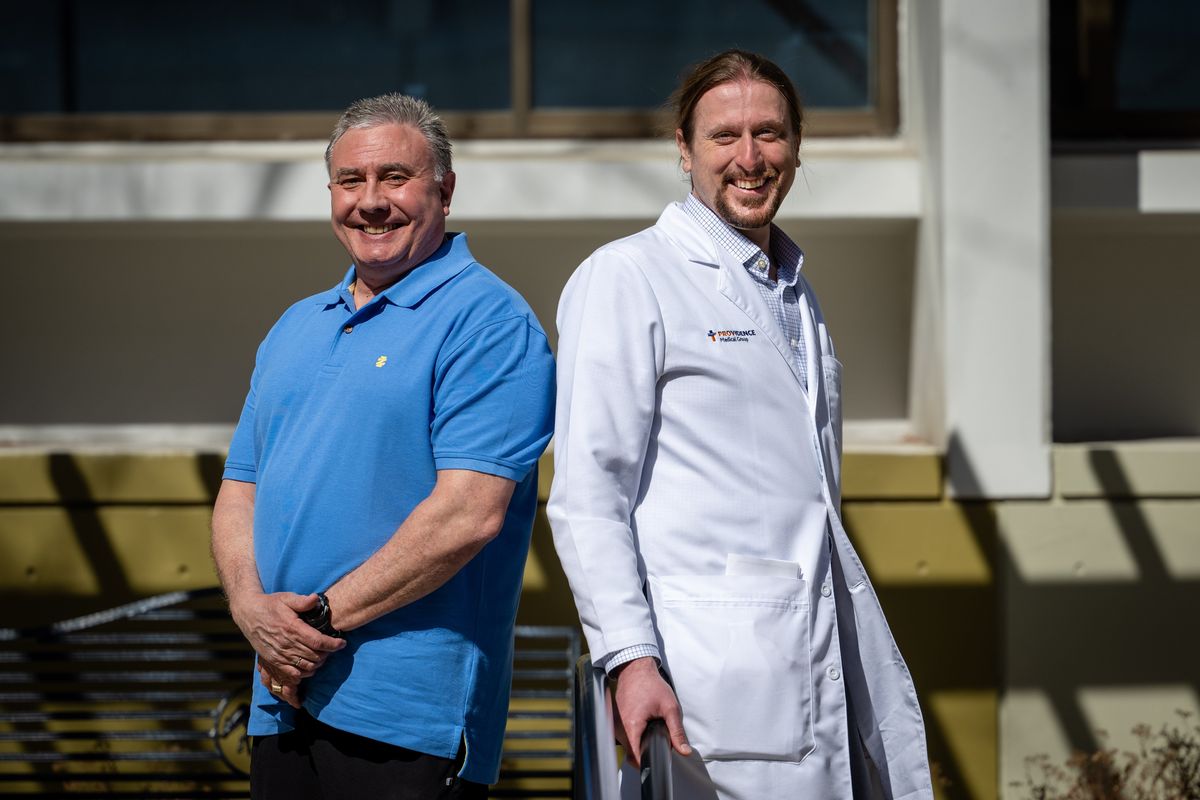Highs and lows: Traumatic brain injury requires multifaceted rehabilitation care
Sixty-year-old Anthony Guastella, left, was injured in December 2020 while working out in his garage. A heavy hook that was holding his workout band dislodged from the ceiling and hit him in the head. He received surgery at Sacred Heart Medical Center for his brain injury and was rehabilitated at St. Luke’s Rehabilitation Medical Center. Dr. Frank Jackson, a Providence Osteopathic Medicine physician, was Guastella’s admitting physician. (Colin Mulvany/The Spokesman-Review)Buy a print of this photo
Exercising in his Spokane Valley garage more than a year ago, Anthony Guastella was hit in the head by a piece of heavy equipment. His traumatic brain injury was far worse than a concussion.
On Dec. 30, 2020, a heavy hook for holding his workout bands dislodged from the ceiling and struck him. Guastella, 60, didn’t lose consciousness, but it knocked him flat onto the floor. He couldn’t move his left side or roll over, and eventually blood became noticeable.
“It cracked my skull,” Guastella said. “I’d lost all the motor function on the left side of my body.”
Immobile, he yelled for his wife. She called 911.
Traumatic brain injuries come in many forms – perhaps a skull fracture, contusion, brain bleed or even from a stroke, said Dr. Katie Huynh, neurosurgeon with Providence Spokane Neuroscience Institute and one of the first doctors to see Guastella. Arriving at the hospital, he had all of the above except for a stroke, which had to be ruled out because of the paralysis, she said.
“His injuries were profound in the sense he had an open laceration of his scalp on that right side, then underneath that he had a skull fracture,” Huynh said.
“It wasn’t a simple skull fracture, it was fairly complex. The bone was depressed, so it had sunken in beyond the skull cavity and was pushing on his brain. It also lacerated his brain, so he had different types of brain bleed underneath. Everything is location, location, location for the brain, so it just so happened that where he had the laceration and brain bleed was where all the controls for movement on the left side of the body was located.”
Guastella’s parietal bone was broken over the crucial motor area, she said. He needed surgery for repairs. Neurosurgeon Dr. Gina Monaco did the next-morning surgery, also placing titanium mesh to cover the defect over his skull and for protection because the bone was shattered, Huynh said. After a hospital stay, Guastella was transferred Jan. 8 to Providence St. Luke’s Rehabilitation Medical Center, but he still couldn’t move his left side.
St. Luke’s physiatrist Dr. Frank Jackson and specialists then developed a strategy considering the brain’s complexity, mental exercises and brain-muscle connections.
That rehabilitation period was expected to go up to four weeks. It took 18 days.
“The therapists, the doctors, everybody was just fantastic, very supportive,” Guastella said. “Dr. Jackson told me, it might have been on the first day or the second, ‘You’re going to have good days, and you’re going to have bad days. Don’t get too excited on your good days, and don’t get too down on your bad days.’ ”
That proved true.
TBI recovery
Providers often have to consider if part of the brain is injured or the whole brain, both causing different issues, Jackson said. Guastella dealt with both.
“Because of that very specific injury he had from that weight hitting him on top of head, it affected the part of his brain that helps control some functions,” Jackson said.
“The whole brain, that’s more general cognition or a person’s level of thinking, so it can affect attention, memory and executive functions such as their ability to make decisions. With Anthony, I don’t know that his executive function was affected, but I think his memory and some of his concentration and attention issues were.”
Using shared Providence records, rehabilitation specialists review initial providers’ notes and communicate with them. At St. Luke’s, Jackson and an internist monitored his medical needs such as surgical wound care, pain and Guastella’s Type 1 diabetes.
Other factors must be monitored, Jackson said, such as a patient’s electrolytes. Some brain injury impacts are predictable, he said.
“Unfortunately, when you have a traumatic brain injury and it affects the whole brain, sometimes the MRIs don’t show all of that, but we still see functional deficits.”
That’s why providers test repeatedly on attention, memory and executive function as well as balance, movement and self-care competencies.
Various therapies
Along with a goal to restore connections between the brain and muscles, there’s movement.
Absent mobility, therapists manipulate limb movement while protecting joints and considering range of motion, said Jackson, who manages the rehabilitation. The physiatrist meets regularly with a patient’s team of providers: physical therapy, occupational therapy, speech therapy, dietitian, psychologist, chaplain and recreation therapy.
“We also use things like electrical stimulation,” Jackson said. “We put little pads on the arm and actually deliver a little jolt of electricity there to activate the muscles so A, it stops any atrophy from happening and B, it’s hypothesized that it helps restore those connections between the brain and the muscles.”
All providers supported the highs and lows, Guastella said.
“After I’d been here about a week, I developed blood clots in my legs and three pulmonary embolisms,” he said. “That was probably the low point.”
That required blood thinners and monitoring. Guastella pressed on.
“I tried to work hard, go through the therapy and give it everything I had,” he said. “I prayed multiple times a day, and I would ask for just a small miracle the next day, something that I couldn’t do the day before.”
Guastella became excited at his first left arm bicep curl. He was determined.
“My motto was, working out got me into this mess, working out is going to get me out of it,” he said.
“They taught us about neurogenesis (new neurons formed in the brain). It’s like the street is blocked, so you have to find another way to get it where it needs to get to. That happens when you sleep, so they put you to bed early.
“I started to get minor movement in my hand probably about five days after coming here. The leg was the last thing to come around.”
One therapist played Sammy Hagar tunes as a mood-lifter. Equipment helped, such as parallel bars to brace initial steps, eventually stairs, a seated exercise bike and the ZeroG Gait and Balance System, with robotic body-weight support equipment. By his discharge, Guastella moved with a walker, although his left foot dragged a bit. He improved with short walks and outpatient rehabilitation.
‘Don’t give up’
At St. Luke’s, Guastella worked with a therapist on regular mental exercises – solving mazes on paper, card strategy games and Sudoku puzzles. At first, he could complete a Sudoku only partially.
In outpatient therapy until recently, he is largely recovered with only slight residual issues. His fingers might tingle. Sometimes, he can’t remember where he puts a note or the meaning of an acronym. He plans to keep up mental puzzles and goes to a gym.
“I have some nerve things, my memory isn’t as good as it was, and sometimes I get dizzy when I lay down,” he said. “I took a pretty good shot on the head, and now that my body’s back, I have to take care of my brain.
“One question I get is what advice do I have for people in the same boat, and I’d say, ‘Just work hard, don’t give up, and pray.’ ”


